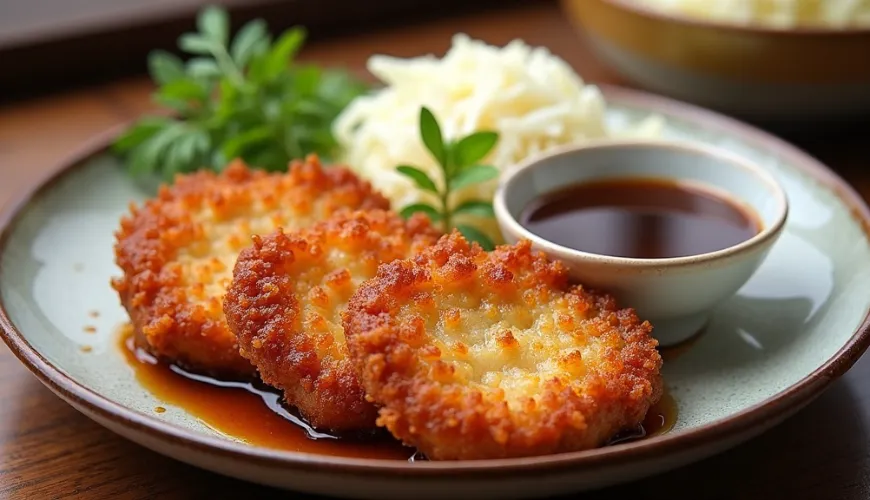
Tonkatsu preparation at home easily and deliciously

Japanese Tonkatsu - A Crispy Classic That Has Conquered the World
When you say schnitzel, most Czechs immediately think of the classic pork schnitzel, coated in breadcrumbs and fried until golden brown. But what if there is a variant that combines familiar taste with an exotic twist while maintaining simplicity? We are talking about the Japanese schnitzel called tonkatsu – a culinary phenomenon that has captured hearts not only in Japan but also in many other countries.
At first glance, it's a simple dish: pork schnitzel coated in breadcrumbs and fried until golden. However, tonkatsu is not just any fried slice of meat. It embodies a refined preparation technique, selected ingredients, and one indispensable component – tonkatsu sauce, which gives the dish its characteristic flavor.
How Tonkatsu Originated and Why It's Called the Japanese Schnitzel
Tonkatsu has a surprisingly short yet fascinating history. It was created at the turn of the 19th and 20th centuries during the Meiji period when Japan was opening up to the Western world. During this time, the so-called yōshoku cuisine began to emerge – Japanese versions of Western dishes. One of the first such attempts was tonkatsu, inspired by the Austrian Wiener schnitzel.
Instead of veal or chicken, pork began to be used in Japan – specifically, shoulder or loin. And instead of fine breadcrumbs, it was coated in Japanese panko breadcrumbs, which are airier and remain crispier after frying. This coating gives tonkatsu its typical audible crunch when bitten into.
Today, tonkatsu is a common part of Japanese restaurants and households. It is served not only on its own with rice and cabbage but also as part of other dishes – for example, as a filling in a sandwich (katsu sando) or as part of the dish katsu curry, where it is combined with Japanese curry.
Tonkatsu Sauce - The Secret to Perfect Flavor
What really sets tonkatsu apart from an ordinary schnitzel is tonkatsu sauce. This dark, thick, and slightly sweet sauce is an integral part of the experience. Many people compare it to Worcestershire or barbecue sauce, but it has its own character.
The base of tonkatsu sauce is a combination of fruits, vegetables, vinegar, sugar, and spices – most commonly tomatoes, plums, apples, onions, and garlic. The result is a flavor that is sweet and sour, slightly spicy, but at the same time very balanced. In Japan, there are several brands that produce tonkatsu sauce, with the most famous probably being Bull-Dog Sauce.
This sauce is poured directly onto the schnitzel or served in a small dish on the side, so everyone can dip according to taste. This element makes tonkatsu more than just another "fried schnitzel" – it becomes a harmonious combination of textures and flavors.
Homemade Tonkatsu Preparation
Even though it might seem like a complicated dish, tonkatsu is surprisingly easy to prepare at home. All you need are a few basic ingredients and a little patience. The key to success is quality meat – preferably pork loin or shoulder with a bit of fat to keep it juicy. The meat is lightly pounded, salted, peppered, and then coated in flour, egg, and panko breadcrumbs.
The difference from the classic Czech schnitzel lies in the panko – it gives the schnitzel a finer yet crispier texture. It is fried in a higher layer of oil at medium temperature, so the meat cooks through and the coating doesn't burn.
After frying, it's good to let the schnitzel rest on a paper towel to remove excess oil. Then, simply slice the schnitzel into strips, arrange it on a plate with rice, add thin slices of cabbage, and don't forget the tonkatsu sauce.
A Life Story - Tonkatsu Under the Cherry Blossoms
One of the moments when tonkatsu becomes more than just food is the Japanese hanami – the traditional cherry blossom viewing festival. Families and friends gather in parks, spread out blankets, and bring out homemade delicacies. Among them, tonkatsu schnitzels wrapped in bento boxes are often present.
One family, for example, prepares tonkatsu every year according to their grandmother's recipe, inspired by Tokyo. Each family member has their own task – someone coats the meat, another prepares the sauce. And when it's ready, they head to the park under the cherry blossoms, where they enjoy tonkatsu in an atmosphere as delicate and nostalgic as the taste of the schnitzel itself.
"Tonkatsu is not just food for us. It's a ritual that brings us together every year," says Mr. Kobayashi, whose family has upheld this tradition for three generations.
Why Tonkatsu Captivates Hearts Beyond Japan
In a world where there is an increasing emphasis on authentic cuisine and honest ingredients, tonkatsu naturally fits. It offers something familiar – a fried schnitzel – but adds a new dimension through its culture, sauce, and way of serving. Perhaps this is why it has recently appeared on the menus of modern bistros, food trucks, and luxury restaurants.
Moreover, tonkatsu is easily adaptable. There are vegetarian versions with tofu, cauliflower, or eggplant, as well as versions with chicken (chicken katsu) or even fish. The possibilities are endless – and this flexibility makes it a favorite dish in many countries.
In the Czech Republic, tonkatsu is increasingly appearing not only in Japanese restaurants but also in home kitchens. Recipes are shared on blogs, in cookbooks, and on social media. And it's no wonder – few things combine the comfort of the familiar with the charm of the unknown so well.
What to Take Away from the Tonkatsu Story?
If you're looking for something new that won't shock your taste buds, tonkatsu is a great choice. It's a dish you can easily prepare at home, but it also takes you on a journey into Japanese culture. Whether you serve it as a main course, in a sandwich, or with curry sauce, one thing is certain – with every bite, you'll feel that simplicity can be as impressive as complex gastronomy.
And maybe, the next time you're preparing schnitzels for Sunday lunch, you'll try swapping the classic breadcrumbs for panko, add a drop of sweet and sour sauce, and consciously enjoy a taste that bridges continents. Because sometimes, just one small step to the side – and you find yourself in a completely different world.

